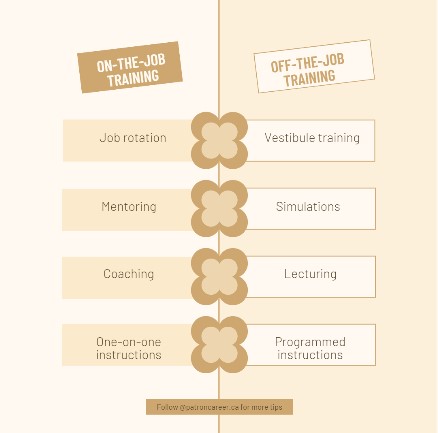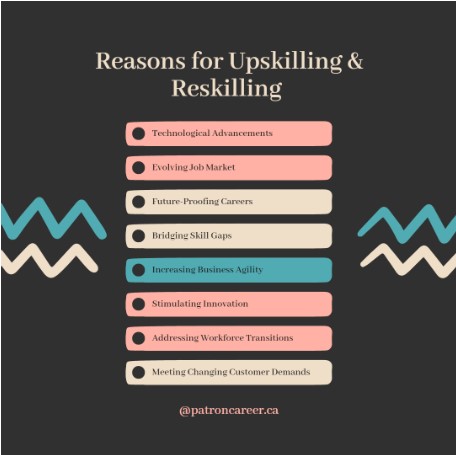
Eliminating Unconscious Bias at Work
4 July, 2023
Patron Career Staffing firmly believes in adopting a tailored approach to meet temporary and permanent recruitment needs. We safeguard the interest of our clients by finding such workers who are knowledgeable and reliable.
About UsNeed help? Make a Call
32 Dundas Street East Unit A, L5A1W2

Often a company’s capableness to navigate a dynamic business environment with precision, speed, flexibility, creativity and customer-centricity is thwarted due to its lack of commitment to ongoing learning and development. Whereas, an organization which centres its culture on continuous improvement of its workforce through upskilling or reskilling is always future-ready and headed towards success. Employees who are the sterling assets of an organization should be constantly fed with new skills and knowledge to promote innovation and keep them at par with market trends.
Through this article, we aim to explore numerous techniques that companies can adopt to nourish workforce expertise and maintain their business agility. But first, let's elucidate the meaning of these two terms, which often are commutated but have several significant differences.
What are Upskilling and Reskilling?
Upskilling and reskilling foster business agility by offering tantamount opportunities for your employee growth and development.
An employee’s current skills may not match the future requirements of the job with shifts in technology, client tastes and preferences, climate change, demographic changes, and urbanization. With the undreamt irruption of the COVID-19 pandemic, the realm of employment has altered how companies used to get their things done. The current corporate sphere mandates the role of adopting new skills- especially, reskilling and upskilling.
Reskilling, as the name suggests, involves helping employees transition into new job roles, requirements and domains. Herein, they are made capable of learning to acquire new and different skill sets. They are trained to fulfilling future tasks through reskilling.
On the other hand, Upskilling refers to enhancing and developing existing skills of employees to meet future demands ad requirements of their current roles. A company may do good by harnessing the power of both these initiatives to ensure employee productivity and uplift their chance to fulfil their potential.
Also read: Eliminating Unconscious Bias in the Workplace: Creating a Fair and Inclusive Environment
Techniques for Fostering Reskilling and Upskilling, Successfully
Effective implementation of strategies is required to maximize the impact of these initiatives. You can consider the following techniques to upgrade your workforce skills:
1. Conduct Skill Assessments to identify gaps
Skills assessments and gap analysis are some of the prominent methods to determine the current competencies of your workforce. It aids leaders to identify skill gaps and gauge the effectiveness of these initiatives. You have to set up indicators to check your employee’s productivity, problem- solving, and ability to lead and accomplish business goals. Some of the best practices companies can utilize are self-assessments, in-person interviews, and ability tests to assess cognitive abilities and aptitude- both verbal and logical.
2. Personalized Learning and Enrichment Programs
All employees who qualify for the upgradation of skills must be exposed to quality learning programs that cater to their skill gaps. You have to utilize a mix of training techniques, such as:

Willing to learn more about other training modules you can implement to boost your organizational agility, click here.
3. Cross-Training and Job Rotation
These are managerial techniques that enable employees to gain exposure to new skills and capabilities. It extracts them from their monotonous work and allows them to be in someone else’s shoes. Job rotation allows employees to explore various job roles and departments that indeed boost their engagement and motivation. For instance, moving an employee across departments will give them in-depth knowledge and experience of diverse job assignments and tasks.
4. Collaborative Partnerships
Leverage external partnerships by getting assistance from educational institutes, industry experts, professional coaches, and other related organizations. You may use your company’s extensive networks to associate with other institutions and foster a learning culture in your workspace.
5. Job Performance Aids
You may take the help of several performance support tools available in the job market, such as job aids, reference materials, online courses, seminars and so on. Collect feedback from your workforce after implementing said tools for a comprehensive learning experience. Your employees will quite thank you for these reinforcements and upgradation to their learning and development. Try to include as many vocational and practical learning tools as possible.

Gamification and Microlearning: The Fruitful Learning Endeavours
The world of work has come up with interactive learning approaches to make learning even easier for employees. We are talking about incorporating game-like elements into the learning process which is a non-game arena. Employees especially millennials respond to interactive and immersive learning approaches. With microlearning, you have to deliver learning contexts by dividing them into digestible learning bits. Level up your game by fostering highly effective training and skill enrichment initiatives by combining work with fun.
Lastly…
Companies pursuing to thrive in the industry ecosystem should largely be dependent on promoting a culture of learning within the organization. Eventually, everything boils down to one aspect-your effectiveness in people management. To not hit rock bottom, and only step on the ladder of success, try inculcating a combination of techniques and ideas that we shared above and drive business agility.
